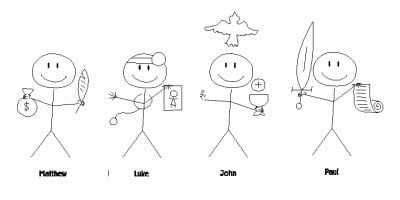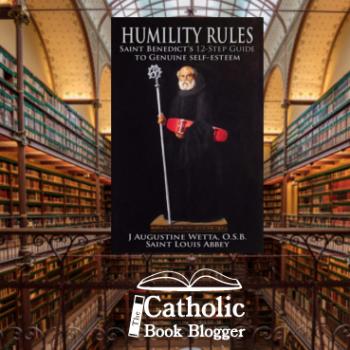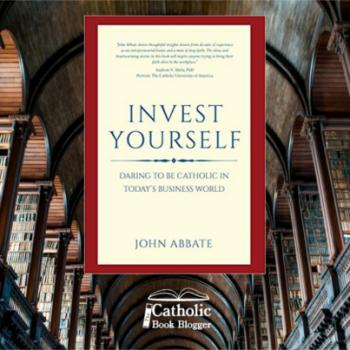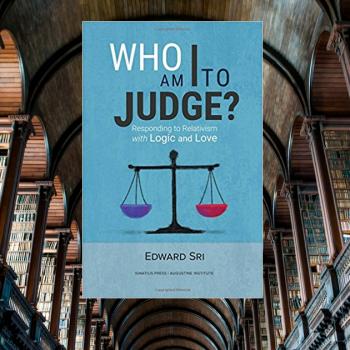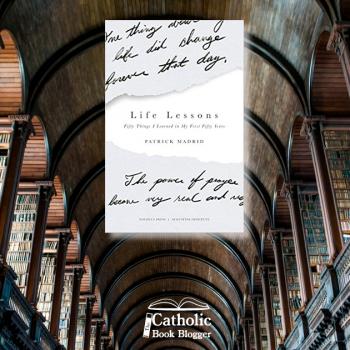 John Bergsma is back with a follow up to his very popular book Bible Basics for Catholics: A New Picture of Salvation History
John Bergsma is back with a follow up to his very popular book Bible Basics for Catholics: A New Picture of Salvation History. This time around he tackles the New Testament exclusively in New Testament Basics for Catholics
. This is a longer volume than the first, coming in at nearly 100 pages more. Considering the first book covered all 27 books of the Bible you can quickly see that this is going to be a highly detailed look at the New Testament.
If you have read his first offering, you will be pleased to hear that the stick figure drawings are back. Sprinkled throughout the book these serve as visual aids in piecing together the timeline of the Bible. They are just as valuable in the volume dedicated to the New Testament.
Of interest is the fact that John does not focus on every book in the New Testament. He recognizes that much of the story told within the first four books repeats itself to some extent. To simplify the study of the New Testament and break it into memorable chunks he chooses to focus on four authors. Matthew, Luke, Paul and John account for 85% of the content in the New Testament. If we understand their writings, we will have a pretty clear understanding of the entire second half of the Bible.
The author states (and I agree): “These four men give us the majority of the New Testament. Of course, modern scholars have cast doubt on whether they wrote the books that bear their names. But I think there are good reasons to trust the traditions of the Christian people about who wrote their most precious texts. So, if we concentrate on getting to know these four, we’ll get the “big picture” of this holy book.”
If you have not read Bible Basics for Catholics don’t worry. Chapter one takes the reader through a thirteen-page crash course of the six covenants “episodes” that lead up to the New Testament. They are the Adamic Covenant, the Noahic Covenant, the Abrahamic Covenant, the Mosaic Covenant, the Davidic Covenant and finally the New Covenant. From here we have the foundation upon which the New Testament is built.
The rest of the book is divided into four parts. Part I: The Kingdom of God Has Come! focuses on the Gospel of Matthew. Part II: The Kingdom of God Grows! looks at the Gospel of Luke and the Acts of the Apostles. Part III: Living in the Kingdom! gives insight into St. Paul and the Letter to the Romans. Part IV: The Kingdom Perfected! wraps up the book with a study of the Gospel of John and The Book of Revelation.
John focuses on two of the four Gospels to begin the book. In Matthew he looks at the five major sermons of Jesus: The Sermon in the Mount, The Mission Sermon, The Parables of the Kingdom Sermon, The Mercy Sermon and The End Times Sermon. Completing the study of Matthew, we review the Christmas story, Jesus announcing the kingdom, Jesus sending out his royal officers, Jesus’ teaching on the hidden kingdom, Jesus’ teaching on the forgiving kingdom, Jesus’ teaching on the end of the kingdom and finally the Easter story. Moving forward John breaks Luke down into four main sections. Jesus’ childhood, Jesus’ early ministry, Jesus’ final journey to Jerusalem, and Holy Week. By taking this approach the main themes of the Gospels are all covered.
The sequel to the Gospel of Luke: The Book of the Acts of the Apostles is covered next. As John states: “While we have four biographies of Jesus, we have only one of the infant Church. We should be grateful to St. Luke for recording for us the beautiful accounts of the Ascension, Pentecost, the Martyrdom of Stephen, the Calling of St. Paul, and so many other earthshaking events that shaped the Church and the history of the world.” The topics mentioned in this quote are covered as well as a rather lengthy look at St. Peter and the Gentiles.
In opening part three and his focus on St. Paul’s Letter to the Romans, John gives a quick overview of the fourteen epistles of Paul. Romans was chosen as the focus for more in depth study as it was Paul’s longest and perhaps most influential epistle. “He lays out his theology in greatest depth, emphasizing that the Good News of Jesus Christ is the way of salvation for all human beings, whether they are Jews, Greeks, or barbarians.” The Letter to the Romans is broken down into four sections: Opening greeting (1:1-7), Doctrinal section (chapters 1-11), Practical section (chapters 12-15) and Closing instructions, greetings, and blessings (15:14 to end).
In the beginning of his study of the Gospel of John the author states: “What we’re about to study is the greatest piece of world literature, period. This is the most influential, the most widely distributed, and the most historically significant book in human history.” With the Bible being the most widely sold book in the world John holds a special place within the Bible as being perhaps the most quoted book of all. Why is that? “And what we’re going to find out in the next few pages is that the Gospel of John is actually a book about the Catholic sacraments. I invite you to ponder that: the world’s most popular book, the world’s most widely read book, is actually a book about the sacraments of the Catholic Church.” I’ll sum that up with one word…..wow.
To wrap up our deep dive journey through the New Testament John Bergsma takes us through the Book of Revelation. Perhaps one of the most famous books in the Bible it is also one of the most wrongly interpreted. John gives clarity to this book in a relatively short 28 pages. He ably points out that Revelation is a book about the past, the present and the future. I personally found this chapter fascinating.
I invite you to take a journey through the New Testament with the help of author John Bergsma. Presented with clarity and a simplicity that makes the themes of the second part of the Bible approachable to all, this book is a must for anyone wishing to have a deeper understanding of Scripture.
_____________________________________________________________________________________________________
I received a copy of this book from the publisher in exchange for an honest review.

